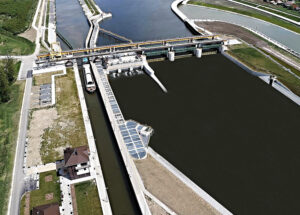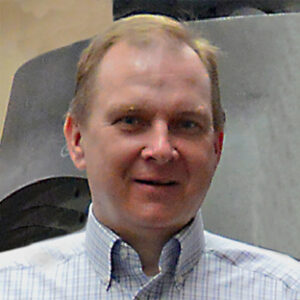Founded immediately after the fall of communism in the former Czechoslovakia, Czech Republic-based Mavel has grown to be a world leader in hydroelectric equipment. While the company provides a full range of turbines, one of its specialties is low-head hydro. Much of Mavel’s low-head hydro expertise was gained through designing and providing turbines for 10 projects on the Odra River, also known as the Oder, which flows through the Czech Republic, Poland, and Germany. In this interview, Martin Sintak, a Mavel founder, owner, and managing partner, tells Hydro Leader the story of the Malczyce hydroelectric plant, one of Mavel’s current projects on the Odra, and provides further details about other similar low-head projects in Central Europe.
Hydro Leader: Tell us about your background and how you started Mavel.
Martin Sintak: I am a Czech citizen and grew up under communism, finishing my studies at the Czech Technical University in 1988, just 2 years before the wall came down. My degree was in civil engineering. After graduation, I started working with a small engineering company in Prague that focused on small hydroelectric power. When the political system changed in 1990, one of my professors brought together a few of his students and we established Mavel. Now, 30 years have passed, and I’ve been with Mavel pretty much my whole working life.
Hydro Leader: What are your responsibilities at Mavel?

Martin Sintak: My responsibilities have evolved during my time here. Originally, we all did some of everything. I did engineering, sales, administration, and hiring—pretty much anything that needed to be done. As the company grew over time, my line responsibilities evolved and shifted, but my focus on low-head opportunities in Central Europe remained unchanged. Now, my responsibilities are split between regional market leadership and oversight of line management. My regional focus has been and remains Central and Western Europe. Originally, I did hands-on work, and my strong relationships within Europe remain, but today I lead a team focused on this region.
In terms of line management, I was the sales director for many years and managed the project management department. Now, however, we are lucky to have strong leaders in both sales and project management, and my role has evolved to that of supporting and overseeing their work. This allows me the flexibility to focus on developing and maintaining customer relationships and to work on sales, corporate strategy, technical innovations, and problem solving.
Hydro Leader: Where is your office?
Martin Sintak: My office is at Mavel’s corporate headquarters in Benešov, a small city 50 minutes from Prague. By design, all management is located in the same complex as sales, engineering, production, purchasing, project management, research and developoment, and service. This has allowed for the seamless interaction of all departments and for a team approach to every project. We have over 110,000 square feet of production space, utilizing state of the art technology, which has provided us with both quality and cost advantages in our markets. The team at the Benešov headquarters is integrated with personnel in North America and at our second production facility near Brno, Czech Republic.
Hydro Leader: What is the meaning of the name Mavel?
Martin Sintak: It is an acronym for the Czech phrase malé vodní elektrárny, which means small hydropower plants. Ma comes from malé, meaning small; the V comes from vodní, meaning water; and el comes from elektrárny, meaning power plant. Together, that makes Mavel.
Hydro Leader: Would you tell us about Mavel’s recent hydroelectric project in Poland, the Malczyce power plant?
Martin Sintak: It has been a politically important project in Poland. The project, owned by local water authority Regionalny Zarząd Gospodarki Wodnej we Wrocławiu (Wrocław Regional Water Management Authority), is located at a new lock and dam structure on the Odra River in southwestern Poland. The project combines an upgrade of the transportation capability of the Odra river and the addition of 9 megawatts (MW) of renewable energy.
The total project includes a new dam with tilting gates, locks, and a new powerhouse with hydroelectric equipment. Mavel was awarded the project in June 2005 as leader of a consortium with Energoprojekt-Warszawa s.a., a local design and engineering company. Energoprojekt provided the design, engineering, electro system, and steel construction. Mavel provided project oversight and equipment design, production, delivery, the turbine and mechanical parts, and commissioning.
Hydro Leader: How many turbines are there, and how big are they?
Martin Sintak: The Malczyze project uses three Mavel Kaplan pit turbines. This is a typical lock and dam project, with a large flow of water and relatively low head. Successfully optimizing power at a lock and dam project like this depends on low-head hydroelectric turbine technology, such as Kaplan turbines, which, fortunately, were invented in the Czech Republic. These double-regulated turbines were invented by Austrian professor Viktor Kaplan in 1912 in what is now the region of South Moravia in the Czech Republic. The Czech Republic continues to be the global center of excellence for Kaplan turbines.
The Malczyce lock and dam site has a flow of 240 cubic meters (8,475 cubic feet) per second and a head of 4–6 meters (13.1–19.7 feet). Mavel is providing three Kaplan pit turbines, each with a power output of 3 MW, giving the whole facility a maximum output of 9 MW. The turbines have a diameter of 3.4 meters (11.15 feet) and three runner blades. For each unit, Mavel is also supplying a gearbox, a generator, a hydraulic power unit, and a control system.
Hydro Leader: How long have you been working on the project?
Martin Sintak: Mavel started working on this project 15 years ago. We won the tender for the design and supply in June 2005. For the first decade, we worked on design, prepared documentation about the position of powerhouse, did modeling work, and then started to produce the turbine technology. Each year, an additional increment of work was authorized by the client.
When we signed the contract in 2005, Malczyce was the biggest project we had ever signed in terms of dollar value, and more importantly, in terms of the size and the power output of the individual turbines. Now, however, we have supplied turbines with significantly larger runner diameters and installed power.
Hydro Leader: Is this project technically distinctive, and was it difficult compared to other projects you’ve done?

Martin Sintak: The project is distinctive in that it is an example of a type of hydroelectric project that is now being developed in many countries of the world, particularly in Europe and North America, where most high-head projects have already been built. Many of the projects we have completed or have underway are lock and dam projects, which involve powering existing infrastructure and improving its environmental effects while contributing to baseload renewable power. The permitting that governs adding power to existing facilities almost always mandates environmental studies, which result in the mitigation of any existing effects.
As for whether Malczyce is difficult compared to other projects, absolutely not. The design and production of Kaplan turbines, particularly low-head Kaplan turbines, is at the heart of our capabilities. This was a big project, but we worked in a consortium with Energoprojekt. Our responsibility was to design the project and to construct the turbines, a generator, a gearbox, a hydraulic power unit, and a control system. Energoprojekt was responsible for the electrical part and for steel construction.
Hydro Leader: Were there existing turbines at the site that you improved on, or was this a wholly new project?
Martin Sintak: This was a new greenfield project. The Odra River has around 25 dams, weirs, and locks on it, and the Malczyce Dam is the newest. The previous one, Brzeg Dolny Dam, was finished in 1959. At the current rate, a dam is repaired or newly built on the river every 50–60 years.
Hydro Leader: Are there plans to put turbines on some of the other nonpowered dams or locks on the Odra River?
Martin Sintak: Good question. Not all the Odra River dams have powerhouses, but most do. Our first project on the Odra River in Poland was the Krepna project, which we signed in 2003. To date, Mavel has provided equipment for a total of 10 power plants on the Odra, and we are beginning another 3 now. Typically, each project has 2 turbines. The 10 power plants currently using Mavel equipment have a total of 22 turbines under operation. The three additional power plants will have 7 turbines. Eventually, we will have 13 power stations on the Odra with a total of 29 turbines. All the projects we are working on now are new construction, not the rehabilitation or replacement of existing turbines.
Hydro Leader: Are you currently building the seven additional turbines you mentioned?
Martin Sintak: We are only doing preliminary work. We expect to get the full go-ahead for the design and production of all three power stations between May and October of this year. We will work on all three projects with a design company we cooperate with often and with our existing customer.
Hydro Leader: At 4–6 meters (13–19.7 feet), these are all fairly low-head projects. Is that the standard drop on almost all the locks?
Martin Sintak: That is the maximum for the Odra River. Normally, the head is only about 2 meters (6.5 feet). The normal range for our turbines on the Odra River is 1.5–4 meters (5–13 feet). It is fairly unusual for turbines to be able to operate at such low heads. Using three-blade technology, our turbines are efficient and have a wide operating range, with wicket gate openings from 20 percent up to 100 percent. We have a few other power stations in operation that operate safely and generate power with head as low as 1 meter (3.3 feet).
Mavel’s many projects on the Odra in Poland are really what built our expertise in very-low-head installations. That experience has made us the global leader in low-head hydro, which is applicable to other markets.
Hydro Leader: Would you tell us about the typical timeline for a project like this and why this one took 15 years to complete?
Martin Sintak: A typical timeline for Mavel to design and deliver turbines and related equipment for a similar hydropower plant is 10–20 months from contract signing, depending on the size of the turbines, the scope of work, and the customer’s preferences. The construction of a new dam and lock certainly take longer. The Malczyce project took so long because the client is a state-owned company that had to resolve many complications, including the location of the new dam, flood water flow, and restrictions related to fishing and the environment. The government was concerned about fish passage, the impact on groundwater, and all the usual obstacles.
Electronic protection against fish and fish passage is popular now. All our new installations have electronic protection against fish. This protection, together with fish passage, enables the safe migration of fish.
The Malcyze hydroelectric power plant is now operated within and integrated into the control room of the Malczyce lock and dam system. The lock and dam system will perform the final testing and technical inspection of the turbine/ generator unit, electrical and control system, gates, and cleaning machines.
Martin Sintak is a founder, owner, and managing partner of Mavel. He can be contacted at sintak@mavel.com.


